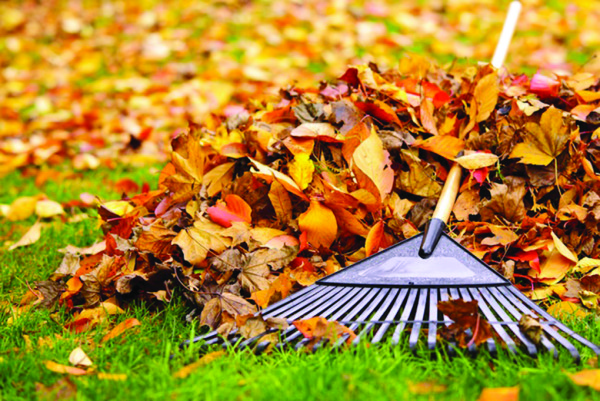
Look at those falling and fallen leaves as a garden enhancer. Yep, decomposed leaves add substance and nutrients to the soil.
An easy way to create leaf mulch is to corral them into a contained area and let them sit over the winter. Periodically, stir up the pile. The leaves will decompose and add a wonderful compost to your spring gardens.
Next Year’s Garden
If you know you want to have a new garden next spring, the fall is an excellent time to build a fertile soil for next year’s plantings. There is very little effort involved in a lasagna garden preparation, and the result far outweighs any effort. Your plants have the benefit of healthy, productive soil. There is no digging or tilling to create this soil!
Lasagna gardening is known by many names: layer gardening, sheet composting, instant gardening, layer cake gardening. The idea is to create great soil for your garden through a layer method.
The method reduces weeding, watering needs and pests. The concept of balancing “brown” and “green” organic matter is similar to creating good compost, which also decays into fertile soil. The idea is to build a garden of organic matter in layers that break down over time creating vibrant, rich soil. Layers are comprised of either “brown” or “green” material.
Samples of brown materials to use for layering are shredded newspapers (no slick, magazine-type paper), farm-animal manure (not dog or cat), worm castings, compost, chopped dried corn cobs, chopped dried leaves, hay, straw, peat moss, aged sawdust (not cedar), chopped stalks and wood ash.
 Samples of green materials to use for layering are eggs shells, coffee grounds, tea bags, grass clippings, fruit and vegetable scraps, chopped green leaves, seedless weeds, garden trimmings such as stalks, deadheaded flowers, etc. Do not use human waste, bones, meat products (including fish), dairy products, diseased or insect infested plants, grease, oils or fats, mature weeds with seeds or whole eggs.
Samples of green materials to use for layering are eggs shells, coffee grounds, tea bags, grass clippings, fruit and vegetable scraps, chopped green leaves, seedless weeds, garden trimmings such as stalks, deadheaded flowers, etc. Do not use human waste, bones, meat products (including fish), dairy products, diseased or insect infested plants, grease, oils or fats, mature weeds with seeds or whole eggs.
To get started, choose a site that gets 6–8 hours of sun each day. The site will suggest the size of your garden. You will want to be able to reach within the garden to weed and harvest. The site should have good drainage. Lay down a layer of cardboard or newspapers. Water it and then add a brown layer with three inches of material; water again. Now add a green layer. The green layer should be about one inch high; water. Alternate brown and green layers until the layers are about 18–24 inches high. You want to water after adding each layer. You can top with phosphorous for healthy roots and/or blood meal for nitrogen (green leaves). Top everything with a layer of peat moss or mulch. The wet layers should be the consistency of a wet sponge.
As the layers break down, the height of the soil in the garden is decreased. You can always add more layers to the garden with the next planting.
You can cover the layers with black plastic, which will expedite the breakdown of the materials. Weigh the edges of the plastic with rocks or soil. After six weeks, the process will mostly be finished. This will be great for a spring planting. If you start this at the start of the gardening season, you can plant your garden right away. Just dig a hole by moving the layers, add a little compost to the hole, insert the plant and replace the layers, firming the layers up against the roots and stem of the plant.
Another option is to plant seeds. Place the seeds in the top layer of peat moss, covering to the appropriate depth, following the directions on the package.
Finally, this lasagna garden could be part of a long term plan. Allow the layers to decompose and create great soil over several seasons. You can expect the height to decrease by one-third to one-half of the original height as the material decomposes.
(The Rutherford County Farmers Market class on lasagna gardening and the UT Extension Service publication were great resources for this information.)
Proposals for Classes
Rutherford County Extension Agent Janie Becker is collecting proposals for classes and teaches at the very popular and free Rutherford County Farmers Market classes, which are offered throughout the open market season. If you have, or know someone who has, a special interest in farming, gardening, landscaping or a food facet, you may propose a one-hour class for consideration. Reach Janie at (615) 898-7710 or jbecker8@utk.edu.
2015 Winter Classes for Master Gardener Certification
Applications are now being accepted for the 2015 Master Gardeners Certification class, which begins Jan 20 and goes through March 4. This year it is a Tuesday evening class from 6–9 p.m. Applications are due by Dec. 1. For an application or more information, visit the Rutherford County Extension Office on John Rice Boulevard, call (615) 898-7710, email mastergardeners.rc@gmail.com or visit mastergardeners-rc.org. A payment of $150 will be due upon acceptance to the program.
Another option is the Garden Basics class, which will be held on Thursday nights from 6–9 p.m. Cost is $45 per person and the class run from Jan. 22–Feb 19. Enrollment is limited and is now open.
Either class would be a great gift!













